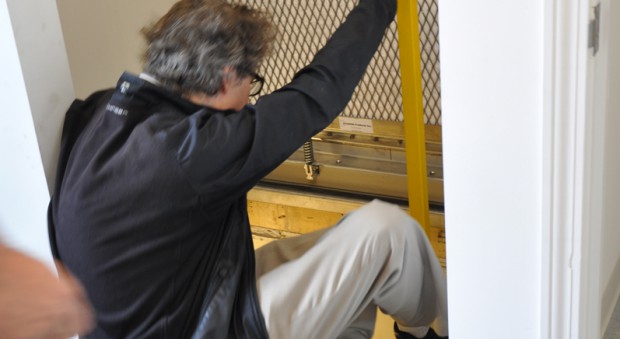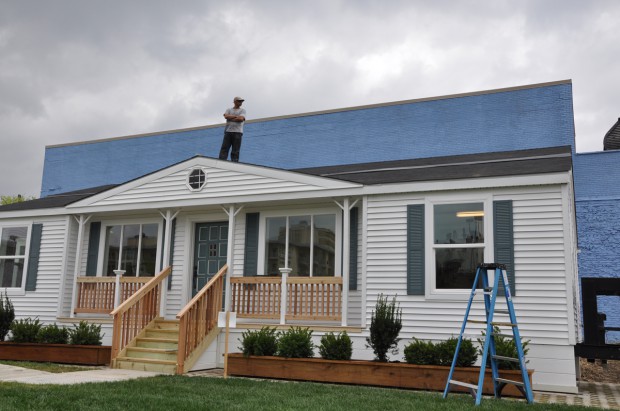At Friday’s preview, the permanent home for Mike Kelley’s Mobile Homestead (a formerly vacant lot behind the Museum of Contemporary Art Detroit) was behind schedule. It swarmed with landscapers laying last-minute sod and construction workers frantically completing the finish work on the ranch-style house before it opened to the public on Saturday. Despite all the busyness of finalizing the actual piece, the scene felt dormant, with only two journalists in attendance, myself included.
Mobile Homestead, a replica of Kelley’s childhood home in a suburb of Detroit, has a lengthy timeline. The first stage of the project, the street-legal mobile home, was completed in 2010 with the help of MOCAD and Artangel with the LUMA Foundation. It was hauled up and down Michigan Avenue in Detroit, and its journey stopping at sites along the way was documented with three video works that were screened at the Whitney Biennial in 2012. Mike Kelley committed suicide prior to the biennial in the early part of 2012, and Mobile Homestead has continued on to completion without its author.
For the citizens of Detroit, the building of the house over the past eight months has been a source of curiosity. “It’s a real spectacle to see anything new being constructed at all,” local resident Peter Murray told me about seeing a suburban home plopped onto Woodward Avenue, one of Detroit’s main downtown streets. In the imagining of this project, Kelley readily voiced his doubts about the function and success of public sculpture in general and, according to MOCAD Curator of Education Katie McGowen, sided with the idea that the public ought to come to art of their own will, rather than have art forced upon them.
As an exploration of this notion, Mobile Homestead will do both. The house will be open 3 days a week from 11am-5pm, and MOCAD staff are already in talks to host meetings for local AA groups, meditation classes and youth philosophy organizations, while the garage will act as a stage for performances. McGowen explained that in its initial traveling stages, Mobile Homestead was more of a “photo op,” but going forward, the museum will aspire for it to serve a function for the community. The mobile section, now housing a very small “library” of donated books, will be detached and travel just once a year, likely to areas of the city where libraries have been closed.
The basement section remains the most curious element of this ambiguous project. Though the public will use the surface level spaces, the underground section of the home will be seen by invitation-only. Artists will be selected to use this space, which is accessible via hatches on the front walk and an interior closet, to perform “private rites of an aesthetic nature”—or in other words, absolutely anything they like. Jim Shaw and Cary Loren will be the first artists to use the basement. The two were Kelley’s former Destroy All Monsters bandmates.
As Shaw stood at the house’s closet, he peered dubiously inside the open hatch outfitted with a ladder that would take him down to the basement: “Can someone come and tighten this?” he asked, before turning and saying, “I’m still a little fearful of this thing.”

Destroy All Monsters’ Jim Shaw descends into the basement of Mobile Homestead for the first time. Photo by Andrew Volk.
Shaw seemed to be channeling the aura of mortality. He then recalled a recent trip to London to see the English post-punk band Magazine: “I looked around at these paunchy, greying men and realized that I was one of them,” he said. The aging artist embarked upon his first descent into the catacombs while Loren arrived with a backpack full of toy musical instruments, presumably so that they could play, as Shaw put it, their “sad, middle-aged songs.”
Though Mobile Homestead has now reached its permanent home, its future still looks uncertain. MOCAD’s staff seems both eager to see Kelley’s vision through, but also reluctant to make the kinds of decisions that encroach upon his authorship. When I inquired about the plans for future artists who will be invited to use the basement space, I was answered with a shrug, and then, “Mike was going to determine that”—a response I heard more than once.



Comments on this entry are closed.